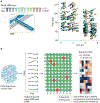Targeting minimal residual disease: a path to cure?
- PMID: 29376520
- PMCID: PMC6398166
- DOI: 10.1038/nrc.2017.125
Targeting minimal residual disease: a path to cure?
Abstract
Therapeutics that block kinases, transcriptional modifiers, immune checkpoints and other biological vulnerabilities are transforming cancer treatment. As a result, many patients achieve dramatic responses, including complete radiographical or pathological remission, yet retain minimal residual disease (MRD), which results in relapse. New functional approaches can characterize clonal heterogeneity and predict therapeutic sensitivity of MRD at a single-cell level. Preliminary evidence suggests that iterative detection, profiling and targeting of MRD would meaningfully improve outcomes and may even lead to cure.
Conflict of interest statement
Competing interests statement
D. M. W. declares that he is a consultant and receives research funding from Novartis, and is a founder of Travera. S. R. M. declares that he is a founder of Affinity Biosensors, and a founder and scientific advisor of Travera. The other authors declare no competing interests.
Figures



References
-
- Buchner T et al. Acute Myeloid Leukemia (AML): different treatment strategies versus a common standard arm--combined prospective analysis by the German AML Intergroup. J Clin Oncol 30, 3604–10 (2012). - PubMed
-
- Armitage JO The aggressive peripheral T-cell lymphomas: 2017. Am J Hematol 92, 706–715 (2017). - PubMed
-
- Scagliotti GV et al. Phase III study comparing cisplatin plus gemcitabine with cisplatin plus pemetrexed in chemotherapy-naive patients with advanced-stage non-small-cell lung cancer. J Clin Oncol 26, 3543–51 (2008). - PubMed
Publication types
MeSH terms
Grants and funding
LinkOut - more resources
Full Text Sources
Other Literature Sources
Medical
Research Materials

